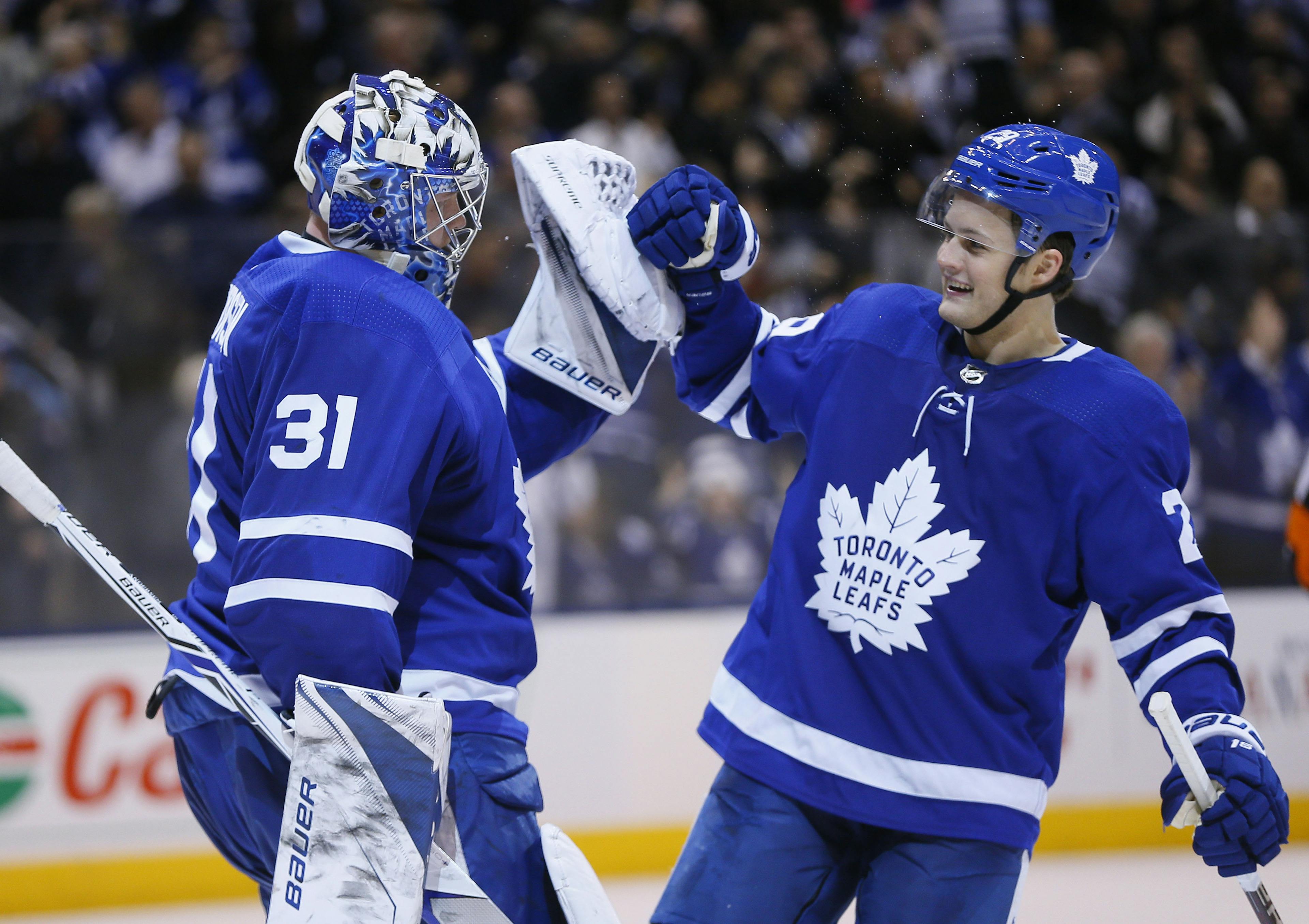Diving into the Leafs’ luck in one-goal games

For those who’ve been involved in the advanced stats community for a while, you’ve probably come to realize that luck plays a pretty big role in team analysis. Bad teams who are getting good results tend to be getting some lucky bounces going their way, and the good teams who are getting bad results tend to be getting some lucky bounces going against them. It’s been a part of analytics long before I even got into them, so I shouldn’t be the one explaining this to you.
Something that’s been raised to my attention is that the Leafs have a lot of wins in one goal games. This is one way to look at a team’s luck, because in close, one goal games, a lucky bounce could be what decides the game.
The Leafs are 21-3-7 in one goal games this season, good for a .677 point percentage, second only to Tampa Bay’s .700. That’s insanely high, especially for a team with only a 50.12% 5v5 Score Adjusted Corsi For% and a 50.62% 5v5 Score Adjusted Expected Goals For%. It makes you think that maybe this Leafs team is worse than their record indicates.
But, I’m here to tell you that maybe that isn’t the case. Without further ado, let’s dive in.

Feb 26, 2018; Tampa, FL, USA; Tampa Bay Lightning goaltender Andrei Vasilevskiy (88) makes a save against Toronto Maple Leafs left wing James van Riemsdyk (25) during a shootout at Amalie Arena. Mandatory Credit: Kim Klement-USA TODAY Sports
Regression
One of the big parts about luck is the eventual regression that comes with it. If a team has extremely good luck one season, that means they’ll suffer some bad luck next season, no matter how much they improved as a team overall. Leafs fans may remember this back in 2013, when the Leafs made the playoffs despite getting extremely out shot most games, and continuing the trend in the 2013-14 season, until the infamous late season collapse.
It also works the other way around. A good example is the Colorado Avalanche right now. Last season, the Avalanche were bad. Like, extremely bad. They had only 48 points last season, if you don’t remember. The thing is, they weren’t actually that bad. In terms of performance, they were a 47.23% 5v5 Score Adjusted Corsi For% team. That’s not good, but it’s also not 48 points bad either. This season, they’re only a 48.37% 5v5 Score Adjusted Corsi For% team, but have 80 points through 68 games. The main difference is their luck. Last season, they’re 5v5 PDO was 97.18, while this season it’s 101.48. So, same team, just completely different ends of the spectrum of luck.
The same goes for the Leafs in one goal games this year. A .677 point percentage is extremely high, and the fact that they’ve only had three one goal games this year where they didn’t get a point is insane. Of course, empty net goals are always a factor, but still, that could be a lot of luck.
But, if you look to last season, the team was not in the same position. Last year, the Leafs had a 14-8-15 record in one goal games, which is a .378 point percentage, good for last in the NHL. Even in the shootout, it never went their way, as they had a 1-8 record, compared to a 6-2 record in it this year. I actually wrote about their bad luck last season during the offseason.
So, my point here is that while the Leafs are seeing some bounces go their way in one goal games this season, it’s not because they’re having this random surge of luck, it’s more of a regression from last season. It doesn’t mean the Leafs should be this amazing one goal game team this season, but it shouldn’t have been a surprise if you looked at the numbers this season.
Shooting Talent
One of the factors of PDO is the team’s shooting percentage. If a team is shooting above the league average, it probably means they’re scoring more frequently than they should be, depending on their shot rates. A team can score a lot and still not have any luck involved, it just means that they’re shooting a lot.
Shooting talent can be very useful in one goal games. Having weapons that can break open a game at any moment is an extremely useful thing to have, and the Leafs have a lot of those. The Leafs have four 20 goal scorers, a 19 goal scorer, and nine players with at least 10 goals. That’s a lot of shooting talent. But, are they lucky, or are they actually skilled.
Here’s a look at the Leafs nine players with at least 10 goals, as well as their 2017/18 shooting% compared to their career shooting%. Note that this is at all strengths.

So, the Leafs have a lot of high shooting percentages this season, but a lot of them are from players who score on a high percentage of their shots. Obviously, there are flaws with this data, as the younger players only have a couple seasons of data to work with, so it’s not a big enough sample size.
But, the highest difference in shooting percentage is Nazem Kadri, and he’s only shooting 3% above his career shooting percentage. Meanwhile, van Riemsdyk is only 2%, Marleau is -1.4% (although that’s a part of the aging curve), and Bozak is -6% (again, aging curve, and he only has 10 goals).
Obviously, some of these shooting percentages are a little alarming, but it does show that the Leafs have some shooting talent, which probably has an impact on their record in one goal games.

Dec 6, 2017; Toronto, Ontario, CAN; Calgary Flames forward Matthew Tkachuk (19) controls the puck against Toronto Maple Leafs goaltender Frederik Andersen (31) and defenseman Jake Gardiner (51) during the second period at the Air Canada Centre. Mandatory Credit: John E. Sokolowski-USA TODAY Sports
Goaltending
The other factor of PDO is a teams save percentage. If a goalie is performing above the league average, there might be some indication that they are benefiting from a little bit of good luck.
But, like shooting talent, if you have a goalie who normally performs above league average, like an in their prime Henrik Lundqvist or Carey Price, a save percentage above league average might be less luck, and more skill.
In the Leafs case, this has been Frederik Andersen. He’s played a huge role in the teams performance in one goal games, always keeping them in it, and usually standing on his head late in the game to secure the win.
This season, he sits at a .919 save%, which is a bit above league average, but not abnormally. It’s also almost identical to his career save%, which is a .918. So, he’s performing at about what he’s expected to.
Now, is Andersen good enough to be able to be in that class of goalies that are more skilled than lucky? Among goalies with at least 2000 minutes over the last three seasons, Andersen ranks 11th in 5v5 dSv% with 0.58. That means that he outperforms his expected save percentage by +0.58% (or .0058 by the NHL’s figures). This is out of 59 goalies, and puts him in similar territory to Henrik Lundqvist and Braden Holtby.
So, Andersen is probably one of those goalies worthy enough to give credit for giving his team some “more luck”.
Curtis McElhinney is a bit of a different story. He has a .931 save% this season, well above his career save%, which is a mediocre .908. You could maybe look at that as something that affects the team’s goaltending in close games, except McElhinney only has played 13 games, not nearly enough to cause a big effect on the team.
So, while the goaltending hasn’t been spectacular all the time, it certainly has been an effect on the team’s performance in one goal games, it’s probably been more towards Andersen’s skill than luck.

Photo by Tom Szczerbowski/USA TODAY Sports
Their 2+ Goal Game Performance
A lot of the times, teams that have a strong one goal game record, but are considered bad, will be terrible in 2+ goal games, because most of their wins came in one goal games, and whenever they lose, they get blown out.
The Leafs are 19-19 in 2+ goal games, although a lot of those are in two goal games, where they are 4-12. As bad as that may seem, if you take a deeper dive into it, it’s not as horrendous. Of the 12 losses, six of them either saw the opponent score an empty net goal in an otherwise one goal game, the Leafs score a goal late in the period in an otherwise three goal game, or the Leafs draw within two goals during a comeback in a game that was otherwise a blowout.
So, half of their 12 losses weren’t necessarily two goal games. Now, they’re still 4-6, which isn’t good, and their four wins probably weren’t all two goal games either, but it’s not 4-12.
It’s still not an ideal situation for the Leafs to be handling 2+ goal games, but Babcock’s system kind of leaves the Leafs in a situation where most of their games are one goal games. And they’re doing pretty well in those.
So, to wrap things up, the Leafs being amazing in one goal games isn’t a sign of bad things to come. It’s actually just the “hockey gods” giving the Leafs a few bounces after last season. Also, their team has enough skill to maintain a higher than normal shooting percentage, and good enough goaltending from Freddy to maintain a higher than normal save percentage.
If there’s one concern, it’s that they aren’t performing as well in 2+ goal games, but it would only be a concern if it was affecting their goal differential, which it isn’t, as their +22 5v5 goal differential is sixth in the league. It’s definitely a red flag, but I don’t think it will be as big of an issue as it might be initially believed to be.
So, remember, no matter what people tell you, the Leafs aren’t a byproduct of good luck, and Buds All Day.
Recent articles from Scott Maxwell





